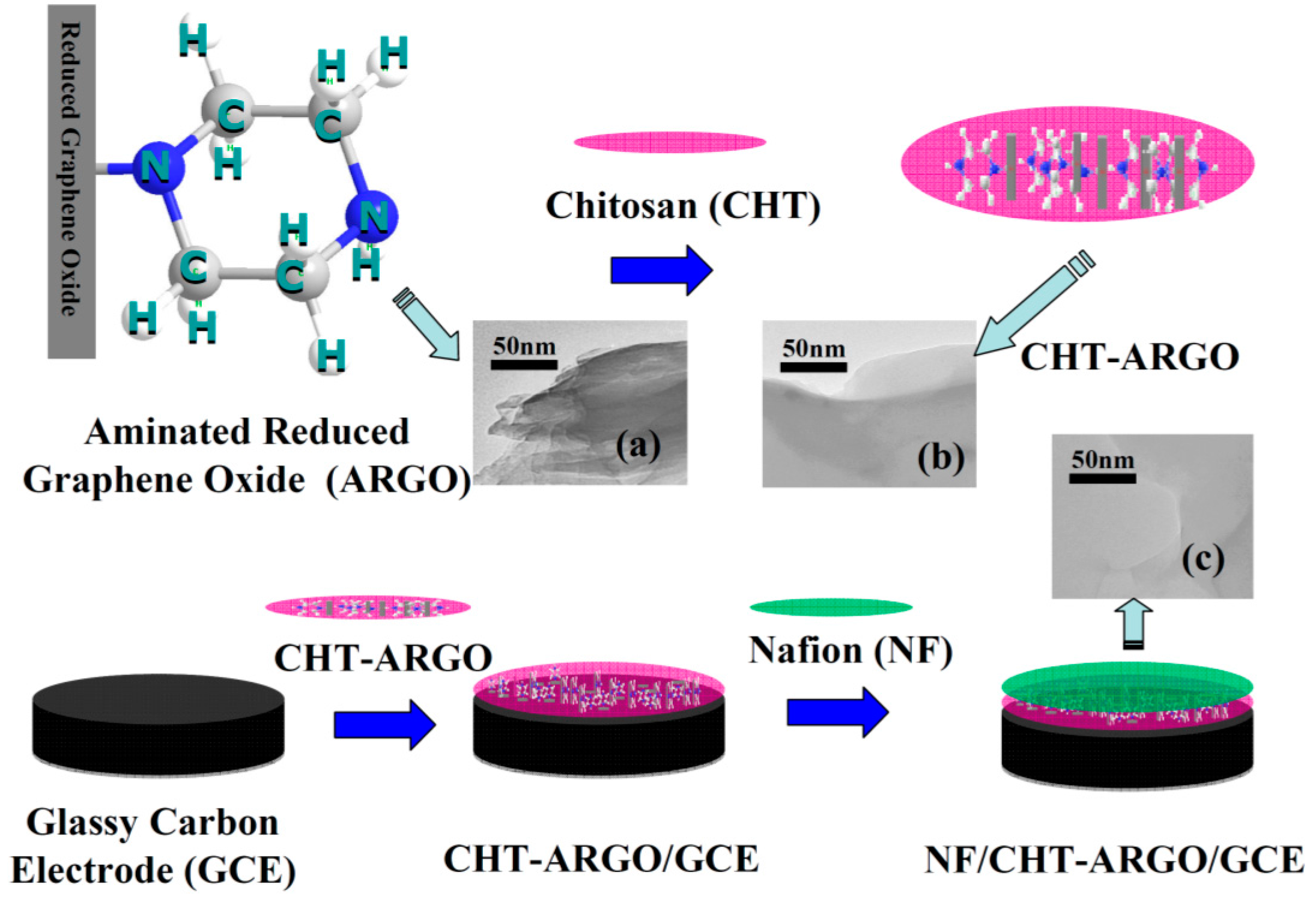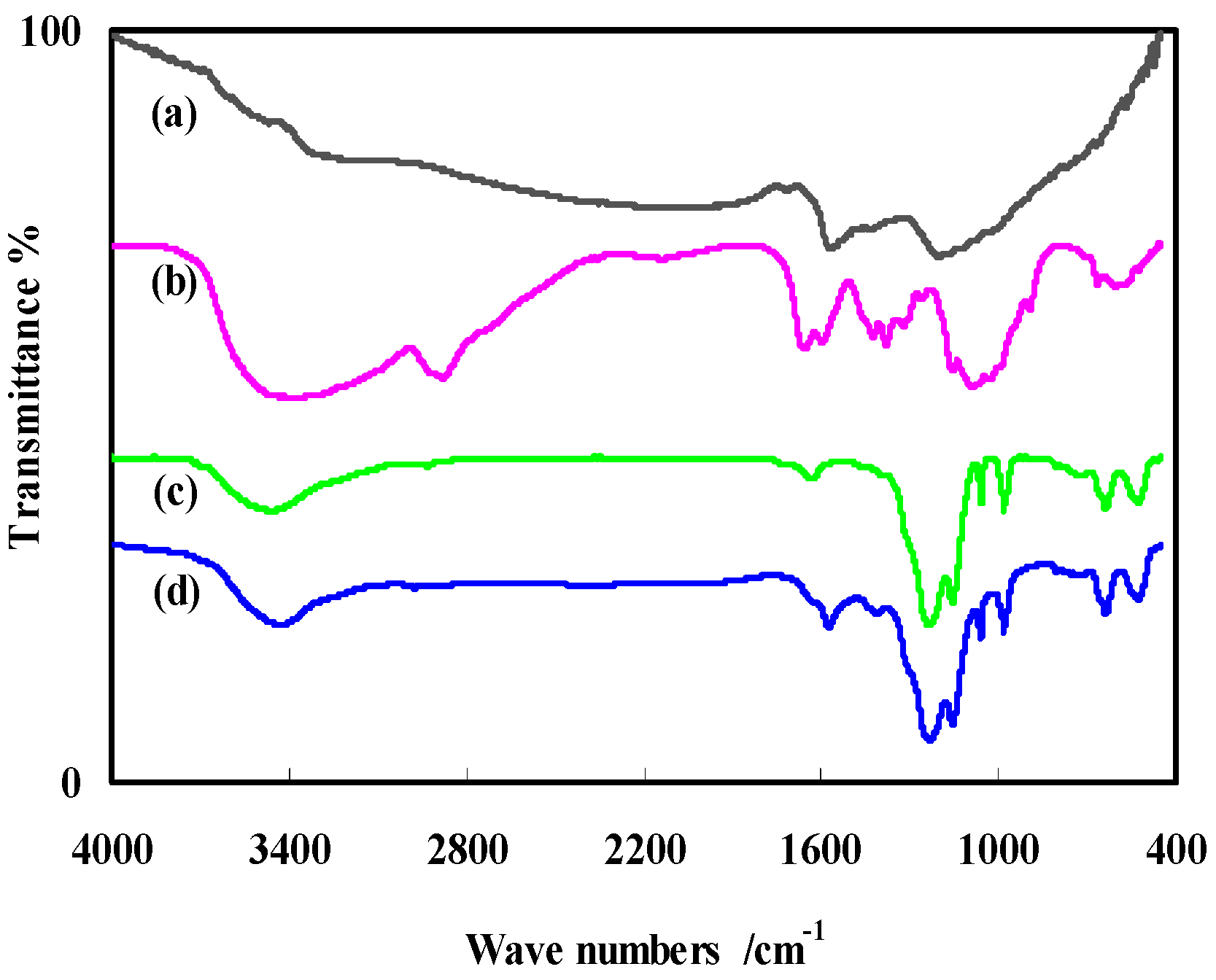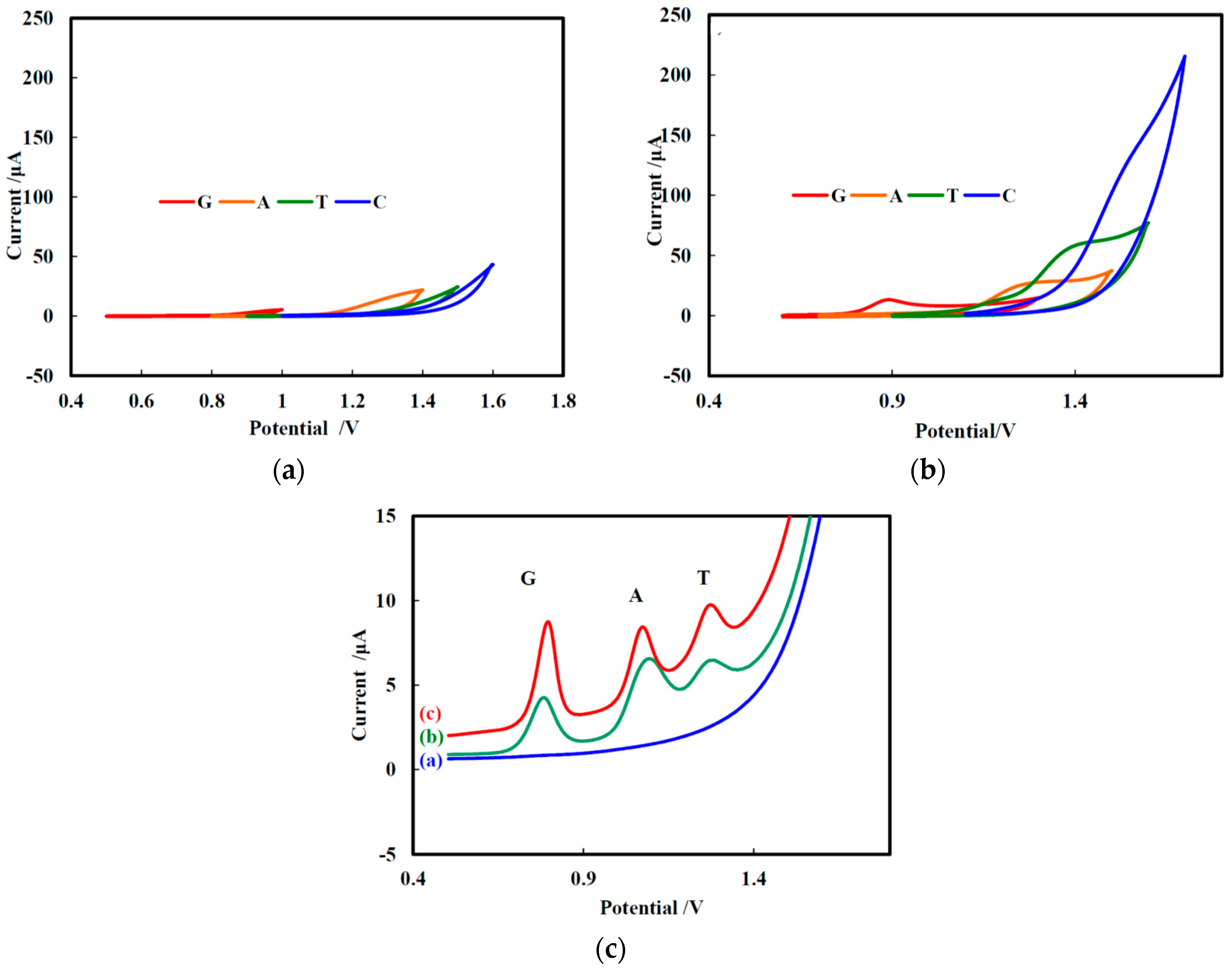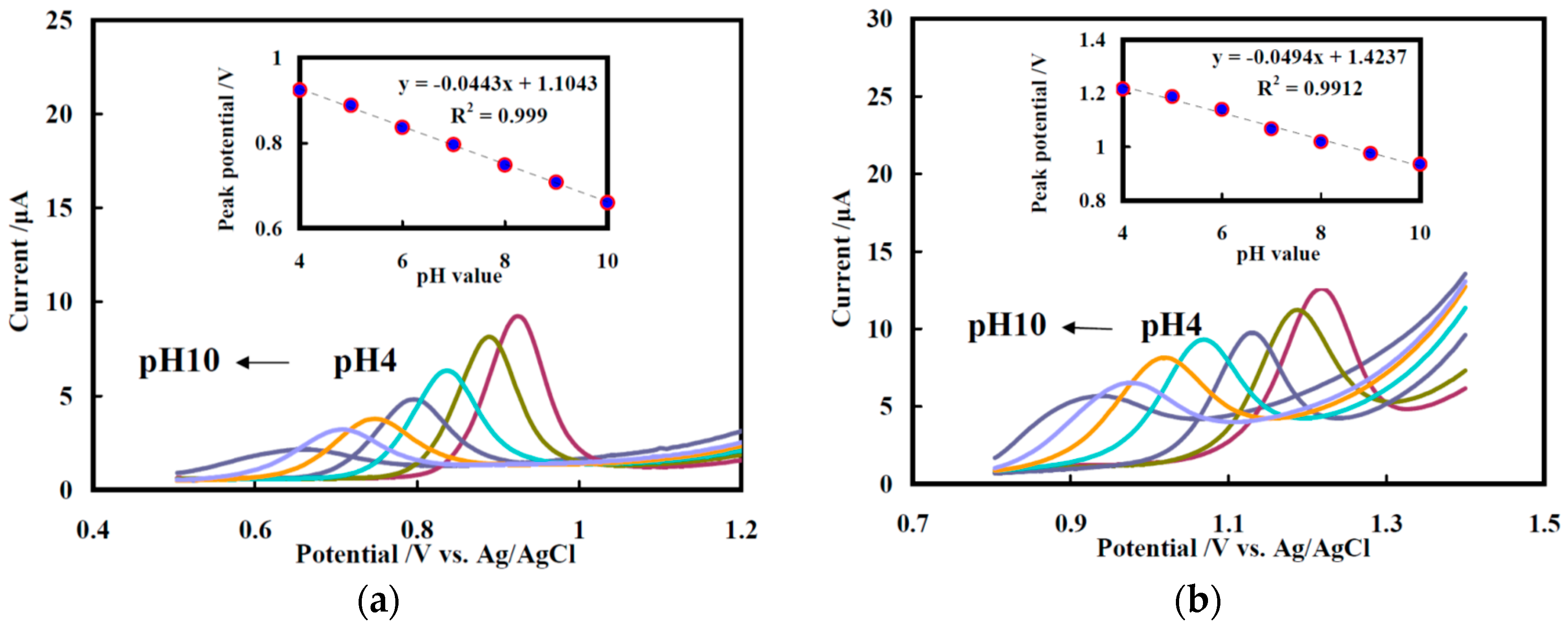Detection of Guanine and Adenine Using an Aminated Reduced Graphene Oxide Functional Membrane-Modified Glassy Carbon Electrode
Abstract
:1. Introduction
2. Materials and Methods
2.1. Reagents
2.2. Fabrication of NF/CHT-ARGO Modified GCE
2.3. Instruments and Detections
2.4. Preparationof the Calf Thymus DNA Sample
2.5. HPLC Analysis on the Real Sample
3. Results
3.1. Microscopic and Structural Studies
3.2. Characterization of Electrochemical Behavior of Different Modified GCEs
3.3. pH Effects Values on Determination of G and A
3.4. Determination of G and A Using NF/CHT-ARGO/GCE
3.5. Potential Applications of NF/CHT-ARGO/GCE
3.6. Reproducibility, Stability and Interferences
4. Conclusions
Acknowledgments
Author Contributions
Conflicts of Interest
References
- Wei, Y.; Xu, Y.; Han, X.; Qi, Y.; Xu, L.; Xu, Y.; Yin, L.; Sun, H.; Liu, K.; Peng, J. Anti-cancer effects of dioscin on three kinds of human lung cancer cell lines through inducing DNA damage and activating mitochondrial signal pathway. Food Chem. Toxicol. 2013, 59, 118–128. [Google Scholar] [CrossRef] [PubMed]
- Hu, C.; Yang, D.P.; Wang, Z.; Huang, P.; Wang, X.; Chen, D.; Cui, D.; Yang, M.; Jia, N. Bio-mimetically synthesized Ag@BSA microspheres as a novel electrochemical biosensing interface for sensitive detection of tumor cells. Biosens. Bioelectron. 2013, 41, 656–662. [Google Scholar] [CrossRef] [PubMed]
- Hu, C.; Yang, D.P.; Wang, Z.; Yu, L.; Zhang, J.; Jia, N. Improved EIS performance of an electrochemical cytosensor using three-dimensional architecture Au@BSA as sensing layer. Anal. Chem. 2013, 85, 5200–5206. [Google Scholar] [CrossRef] [PubMed]
- Goyal, R.N.; Chatterjee, S.; Bishnoi, S. Voltammetric determination of 2-deoxy-adenosine and adenine in urine of patients with hepatocellular carcinoma using fullerene-C60-modified glassy carbon electrode. Electroanalysis 2009, 21, 1369–1378. [Google Scholar] [CrossRef]
- Yang, F.Q.; Guan, J.; Li, S.P. Fast simultaneous determination of 14 nucleosides and nucleobases in cultured cordyceps using ultra-performance liquid chromatography. Talanta 2007, 73, 269–273. [Google Scholar] [CrossRef] [PubMed]
- Kai, M.; Ohkura, Y.; Yonekura, S.; Iwasaki, M. Chemiluminescence determination of guanine and its nucleosides and nucleotides using phenylglyoxal. Anal. Chim. Acta 1994, 287, 75–81. [Google Scholar] [CrossRef]
- Hamberg, M.; Zhang, L.Y. Quantitative determination of 8-hydroxyguanine and guanine by isotope dilution mass spectrometry. Anal. Biochem. 1995, 229, 336–344. [Google Scholar] [CrossRef] [PubMed]
- Todd, B.; Zhao, J.; Fleet, G. HPLC measurement of guanine for the determination of nucleic acids (RNA) in yeasts. J. Microbiol. Methods 1995, 22, 1–10. [Google Scholar] [CrossRef]
- Graven, P.; Tambalo, M.; Scapozza, L.; Perozzo, R. Purine metabolite and energy charge analysis of trypanosoma brucei cells in different growth phases using an optimized ion-pair RP-HPLC/UV for the quantification of adenine and guanine pools. Exp. Parasitol. 2014, 141, 28–38. [Google Scholar] [CrossRef] [PubMed]
- Haunschmidt, M.; Buchberger, W.; Klampfl, C.W. Investigations on the migration behaviour of purines and pyrimidines in capillary electromigration techniques with UV detection and mass spectrometric detection. J. Chromatogr. A 2008, 1213, 88–92. [Google Scholar] [CrossRef] [PubMed]
- Heisler, I.; Keller, J.; Tauber, R.; Sutherland, M.; Fuchs, H. A colorimetric assay for the quantitation of free adenine applied to determine the enzymatic activity of ribosome-inactivating proteins. Anal. Biochem. 2002, 302, 114–122. [Google Scholar] [CrossRef] [PubMed]
- Xiao, F.; Zhao, F.; Li, J.; Liu, L.; Zeng, B. Characterization of hydrophobic ionicliquid carbon nanotubes-gold nanoparticles composite film coated electrodeand the simultaneous voltammetric determination of guanine and adenine. Electrochim. Acta 2008, 53, 7781–7788. [Google Scholar] [CrossRef]
- Tang, C.; Yogeswaran, U.; Chen, S.M. Simultaneous determination of adenine guanine and thymine at multi-walled carbon nanotubes incorporated with poly (new fuchsin) composite film. Anal. Chim. Acta 2009, 636, 19–27. [Google Scholar] [CrossRef] [PubMed]
- Tu, X.; Luo, X.; Luo, S.; Yan, L.; Zhang, F.; Xie, Q. Novel carboxylation treatment and characterization of multiwalled carbon nanotubes for simultaneous sensitive determination of adenine and guanine in DNA. Microchim. Acta 2010, 169, 33–40. [Google Scholar] [CrossRef]
- Thangaraj, R.; Kumar, A.S. Simultaneous detection of guanine and adenine in DNA and meat samples using graphitized mesoporous carbon modified electrode. J. Solid State Electrochem. 2013, 17, 583–590. [Google Scholar] [CrossRef]
- Cui, J.; Sun, D.; Zhou, W.; Liu, H.; Hu, P.; Ren, N.; Qin, H.; Huang, Z.; Lin, J.; Ma, H. Electrocatalytic oxidation of nucleobases by TiO2 nanobelts. Phys. Chem. Chem. Phys. 2011, 13, 9232–9237. [Google Scholar] [CrossRef] [PubMed]
- Niu, X.; Yang, W.; Ren, J.; Guo, H.; Long, S.; Chen, J. Electrochemical behaviors and simultaneous determination of guanine and adenine based on graphene–ionic liquid–chitosan composite film modified glassy carbon electrode. Electrochim. Acta 2012, 80, 346–353. [Google Scholar] [CrossRef]
- Yin, H.; Zhou, Y.; Ma, Q.; Ai, S.; Ju, P.; Zhu, L. Electrochemical oxidation behavior of guanine and adenine on graphene–nafion composite film modified glassy carbon electrode and the simultaneous determination. Process Biochem. 2010, 45, 1707–1712. [Google Scholar] [CrossRef]
- Li, C.; Qiu, X.; Ling, Y. Electrocatalytic oxidation and the simultaneous determination of guanine and adenine on (2,6-pyridinedicarboxylic acid)/graphene composite film modified electrode. J. Electroanal. Chem. 2013, 704, 44–49. [Google Scholar] [CrossRef]
- Kaur, B.; Srivastava, R. Synthesis of ionic liquids coated nanocrystalline zeolite materials and their application in the simultaneous determination of adenine, cytosine, guanine, and thymine. Electrochim. Acta 2014, 133, 428–439. [Google Scholar] [CrossRef]
- Shaidarova, L.G.; Gedmina, A.V.; Zhaldak, E.R.; Chelnokova, I.A.; Budnikov, G.K. Selective voltammetric and flow-injection determination of guanine and adenine on a glassy carbon electrode modified by a ruthenium hexachloroplatinate film. J. Anal. Chem. 2014, 69, 741–749. [Google Scholar] [CrossRef]
- Arvand, M.; Ghodsi, N.; Zanjanchi, M.A. A new microplatform based on titanium dioxide nanofibers/graphene oxide nanosheets nanocomposite modified screen printed carbon electrode for electrochemical determination of adenine in the presence of guanine. Biosens. Bioelectron. 2015, 77, 837–844. [Google Scholar] [CrossRef] [PubMed]
- Yari, A.; Derki, S. New MWCNT-Fe3O4@PDA-Ag nanocomposite as a novel sensing element of an electrochemical sensor for determination of guanine and adenine contents of DNA. Sens. Actuators B Chem. 2016, 227, 456–466. [Google Scholar] [CrossRef]
- Chang, J.; Xiao, W.; Liu, P.; Liao, X.; Wen, Y.; Bai, L. Carboxymethyl cellulose assisted preparation of water-processable halloysite nanotubular composites with carboxyl-functionalized multi-carbon nanotubes for simultaneous voltammetric detection of uric acid, guanine and adenine in biological samples. J. Electroanal. Chem. 2016, 780, 103–113. [Google Scholar] [CrossRef]
- He, W.; Ding, Y.; Ji, L.; Zhang, X.; Yang, F. A high performance sensor based on bimetallic NiCu nanoparticles forthe simultaneous determination of five species of biomolecules. Sens. Actuators B Chem. 2017, 241, 949–956. [Google Scholar] [CrossRef]
- He, W.; Zhang, W.; Zhang, L.; Zhang, X.; Yang, F. A versatile sensor for determination of seven species based on NiFe nanoparticles. J. Electroanal. Chem. 2017, 797, 61–68. [Google Scholar] [CrossRef]
- Geim, A.K. Graphene: Status and prospects. Science 2009, 324, 1530–1534. [Google Scholar] [CrossRef] [PubMed]
- Pumera, M.; Ambrosi, A.; Bonanni, A.; Chng, E.L.K.; Poh, H.L. Graphene for electrochemical sensing and biosensing. TrAC Trends Anal. Chem. 2014, 29, 954–965. [Google Scholar] [CrossRef]
- Stankovich, S.; Dikin, D.A.; Dommett, G.H.; Kohlhaas, K.M.; Zimney, E.J.; Stach, E.A.; Ruoff, R.S. Graphene-based composite materials. Nature 2006, 442, 282–286. [Google Scholar] [CrossRef] [PubMed]
- Robinson, J.T.; Perkins, F.K.; Snow, E.S.; Wei, Z.; Sheehan, P.E. Reduced graphene oxide molecular sensors. Nano Lett. 2008, 8, 3137–3140. [Google Scholar] [CrossRef] [PubMed]
- Ali, M.A.; Kamil Reza, K.; Srivastava, S.; Agrawal, V.V.; John, R.; Malhotra, B.D. Lipid-Lipid Interactions in Aminated Reduced Graphene Oxide Interface for Biosensing Application. Langmuir 2014, 30, 4192–4201. [Google Scholar] [CrossRef] [PubMed]
- Gao, Y.S.; Xu, J.K.; Lu, L.M.; Wu, L.P.; Zhang, K.X.; Nie, T. Overoxidized polypyrrole/graphene nanocomposite with good electrochemical performance as novel electrode material for the detection of adenine and guanine. Biosens. Bioelectron. 2014, 62, 261–267. [Google Scholar] [CrossRef] [PubMed]
- Gao, Y.F.; Yang, T.; Yang, X.L.; Zhang, Y.S.; Xiao, B.L.; Hong, J.; Sheibani, N.; Ghourchian, H.; Hong, T.; Moosavi-Movahedi, A.A. Direct electrochemistry of glucose oxidase and glucose biosensing on a hydroxyl fullerenes modified glassy carbon electrode. Biosens. Bioelectron. 2014, 60, 30–34. [Google Scholar] [CrossRef] [PubMed]
- Hong, J.; Yang, W.Y.; Zhao, Y.X.; Xiao, B.L.; Gao, Y.F.; Yang, T.; Ghourchian, H.; Moosavi-Movahedi, Z.; Sheibani, N.; Li, J.G.; et al. Catalase immobilized on a functionalized multi-walled carbon nanotubes–gold nanocomposite as a highly sensitive bio-sensing system for detection of hydrogen peroxide. Electrochim. Acta 2013, 89, 317–325. [Google Scholar] [CrossRef]
- Hong, J.; Zhao, Y.-X.; Xiao, B.-L.; Moosavi-Movahedi, A.A.; Ghourchian, H.; Sheibani, N. Direct electrochemistry of hemoglobin immobilized on a functionalized multi-walled carbon nanotubes and gold nanoparticles nanocomplex-modified glassy carbon electrode. Sensors 2013, 13, 8595–8611. [Google Scholar] [CrossRef] [PubMed]
- De Moral, P.G.; Arin, M.J.; Resines, J.A.; Diez, M.T. Simultaneous determination of adenine and guanine in ruminant bacterial pellets by ion-pair HPLC. J. Chromatogr. B 2005, 826, 257–260. [Google Scholar] [CrossRef] [PubMed]
- Hong, J.; Moosavi-Movahedi, A.A.; Ghourchian, H.; Rad, A.M.; Rezaei-Zarchi, S. Direct electron transfer of horseradish peroxidase on Nafion-cysteine modified gold electrode. Electrochem. Acta 2007, 52, 6261–6267. [Google Scholar] [CrossRef]
- Prathap, M.A.; Srivastava, R.; Satpati, B. Simultaneous detection of guanine, adenine, thymine, and cytosine atpolyaniline/MnO2 modified electrode. Electrochim. Acta 2013, 114, 285–295. [Google Scholar] [CrossRef]
- Ye, X.; Du, Y.; Duan, K.; Lu, D.; Wang, C.; Shi, X. Fabrication of nano-ZnS coated PEDOT-reduced graphene oxide hybrids modified glassy carbon-rotating disk electrode and its application for simultaneous determination of adenine, guanine, and thymine. Sens. Actuators B Chem. 2014, 203, 271–281. [Google Scholar] [CrossRef]
- Yari, A.; Saidikhah, M. Trithiane silver-nanoparticles-decorated polyaniline nanofibers as sensing element for electrochemical determination of adenine and guanine in DNA. J. Electroanal. Chem. 2016, 783, 288–294. [Google Scholar] [CrossRef]
- Ensafi, A.A.; Abarghoui, M.M.; Rezaei, B. A new electrochemical sensor based on porous silicon supported Pt–Pd nanoalloy for simultaneous determination of adenine and guanine. Sens. Actuators B Chem. 2014, 204, 528–535. [Google Scholar] [CrossRef]






| Working Electrode | Analyte | Detection Limit (μM) | Linear Range (μM) | Technique | Reference |
|---|---|---|---|---|---|
| NF/CHT-ARGO/GCE | A | 0.2 | 0.2–110 | DPV | This work |
| G | 0.1 | 0.1–120 | |||
| GMC/GCE | A | 0.63 | 25-200 | DPV | [15] |
| G | 0.76 | 25–150 | |||
| GS/IL/CHT/GCE | A | 0.45 | 1.5–350 | DPV | [17] |
| G | 0.75 | 2.5–150 | |||
| Graphene-NF/GCE | A | 0.75 | 8–150 | DPV | [18] |
| G | 0.58 | 4–200 | |||
| Nano-ZSM-5/IL | A | 9.5 | 10–300 | DPV | [20] |
| G | 4.8 | 10–300 | |||
| TNFs/GONs/SPCE | A | 1.71 × 10−3 | 0.1–10 | DPV | [22] |
| G | - | - | |||
| MWCNT-Fe3O4@PDA-Ag/CPE | A | 5.66 | 10–120 | DPV | [23] |
| G | 1.47 | 8–130 | |||
| PANI/MnO2/GCE | A | 2.9 | 10–100 | DPV | [38] |
| G | 4.8 | 10–100 | |||
| ZnS-PEDOT-RGO/GC-RDE | A | 0.141 | 0.5–150 | DPV | [39] |
| G | 0.116 | 0.5–150 | |||
| TAN-AgNP-PANT/CPE | A | 2.8 | 1–200 | DPV | [40] |
| G | 4 | 0.9–140 | |||
| Pt–Pd/PSi–CNTPE | A | 0.03 | 0.06–55.0 | DPV/AMP | [41] |
| G | 0.01 | 0.04–53.4 |
| Signal Change | Uric Acid | Glucose | Ascorbic Acid | Vitamin B1 | Vitamin B2 | L-Lysine | Glycine |
|---|---|---|---|---|---|---|---|
| A | 101.6% | 101.5% | 101.8% | 104.0% | 99.3% | 102.3% | 103.6% |
| G | 102.2% | 97.2% | 101.3% | 95.9% | 96.6% | 102.6% | 97.3% |
© 2017 by the authors. Licensee MDPI, Basel, Switzerland. This article is an open access article distributed under the terms and conditions of the Creative Commons Attribution (CC BY) license (http://creativecommons.org/licenses/by/4.0/).
Share and Cite
Li, D.; Yang, X.-L.; Xiao, B.-L.; Geng, F.-Y.; Hong, J.; Sheibani, N.; Moosavi-Movahedi, A.A. Detection of Guanine and Adenine Using an Aminated Reduced Graphene Oxide Functional Membrane-Modified Glassy Carbon Electrode. Sensors 2017, 17, 1652. https://doi.org/10.3390/s17071652
Li D, Yang X-L, Xiao B-L, Geng F-Y, Hong J, Sheibani N, Moosavi-Movahedi AA. Detection of Guanine and Adenine Using an Aminated Reduced Graphene Oxide Functional Membrane-Modified Glassy Carbon Electrode. Sensors. 2017; 17(7):1652. https://doi.org/10.3390/s17071652
Chicago/Turabian StyleLi, Di, Xiao-Lu Yang, Bao-Lin Xiao, Fang-Yong Geng, Jun Hong, Nader Sheibani, and Ali Akbar Moosavi-Movahedi. 2017. "Detection of Guanine and Adenine Using an Aminated Reduced Graphene Oxide Functional Membrane-Modified Glassy Carbon Electrode" Sensors 17, no. 7: 1652. https://doi.org/10.3390/s17071652
APA StyleLi, D., Yang, X.-L., Xiao, B.-L., Geng, F.-Y., Hong, J., Sheibani, N., & Moosavi-Movahedi, A. A. (2017). Detection of Guanine and Adenine Using an Aminated Reduced Graphene Oxide Functional Membrane-Modified Glassy Carbon Electrode. Sensors, 17(7), 1652. https://doi.org/10.3390/s17071652






